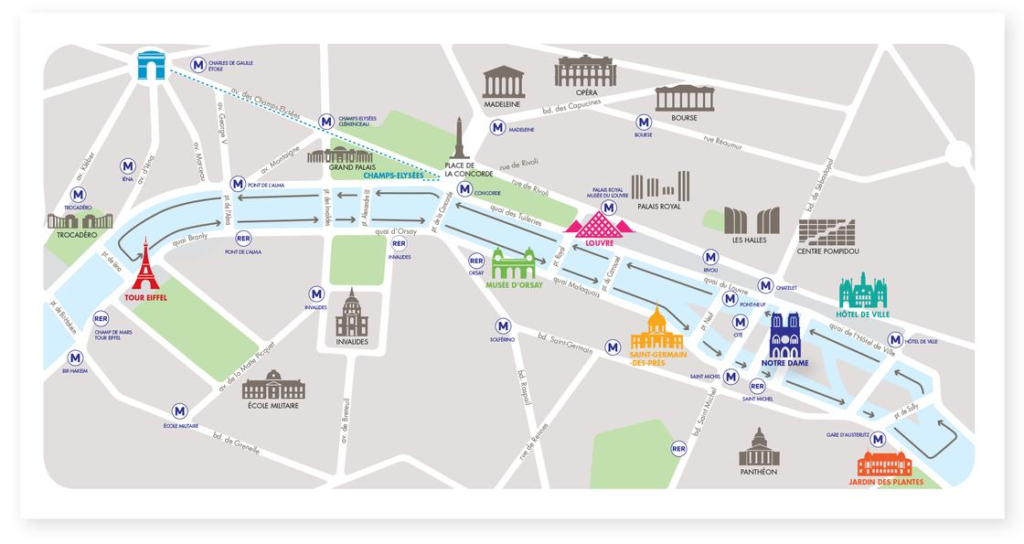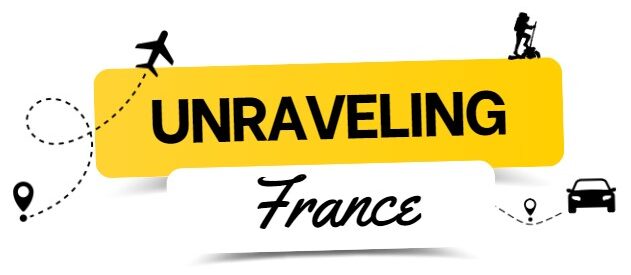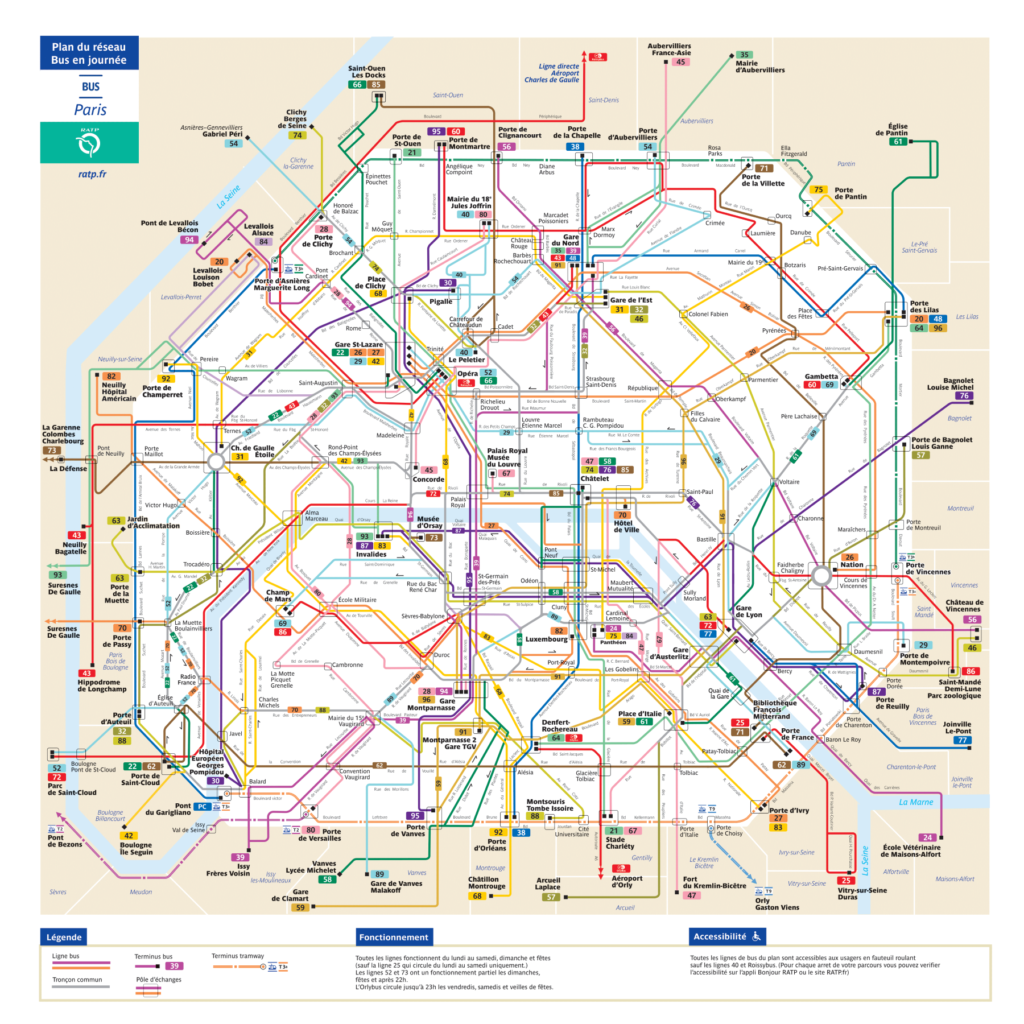Paris, the capital of France, is known for its rich history, iconic landmarks, and vibrant culture. To fully explore the city, one must understand its intricate transportation system. We prepared this guide to help you navigate the variety of ways to get around Paris and quickly reach your desired destinations.
1. Paris Metro
- Description: The Paris Metro is an extensive underground rail system.
- Number of Lines: 16.
- Operation Hours: Approximately 5:30 AM to 1:15 AM.
- Frequency: Every 2-4 minutes during peak hours, and 5-7 minutes during off-peak.
- Ticket Options: Single ride, day pass, weekly pass, or the “Paris Visite” card designed for tourists.
- Note: Maps are available in every station. Look for the sign ‘Plan du quartier’ outside stations for neighborhood maps.
Do You Know ? The metro network in Paris is one of the densest in the world, with a station almost at every street corner in the central areas of the city. No place in Paris is more than 500 meters away from a metro station.
2. RER Trains
- Description: Regional trains connecting Paris to its suburbs and major landmarks like Disneyland and Versailles.
- Number of Lines: 5 (A to E).
- Operation Hours: Similar to the Metro but with slight variations.
- Frequency: Every 7-15 minutes.
- Note: RER requires a different ticket if you’re traveling outside of central Paris. Always keep your ticket until you exit the station.
3. Transiliens (SNCF Suburban Trains)
- Description: The Transilien is a suburban train network operated by SNCF. It connects Paris to its outer suburbs and other cities in the Île-de-France region.
- Number of Lines: 8 (J, K, L, N, P, R, U, and H).
- Major Tourist Destinations Accessible by Transilien:
- Versailles: Take Line L from “Paris Saint-Lazare” to “Versailles Rive Droite” or Line U from “La Défense” to “Versailles-Chantiers”.
- Fontainebleau: Take Line R from “Paris Gare de Lyon” to “Fontainebleau-Avon”.
- Provins (Medieval town): Take Line P from “Paris Est” to “Provins”.
- Note: Transilien tickets are different from standard Paris Metro tickets. Ensure you purchase the correct ticket for your destination. Tickets can be purchased at SNCF counters, machines at train stations, or online.
- Operation Hours: Generally, from 5 AM to midnight, but this varies by line and destination. It’s always a good idea to check the last train’s departure time if you plan to return to Paris the same day.
4. Buses
- Description: Paris buses complement the Metro and reach places the trains don’t.
- Operation Hours: Most lines run from 7 AM to 8:30 PM, with some running later.
- Night Buses (“Noctilien”): Operate from 12:30 AM to 5:30 AM.
- Note: Bus stops display route maps. Buses require the same tickets as the Metro.
5. Trams
- Description: Trams primarily serve the suburbs but can be useful for certain routes in Paris.
- Number of Lines: 8.
- Operation Hours: Varies by line, generally 5:30 AM to 12:30 AM.
- Frequency: Every 6-15 minutes.
6. Taxis & Ride-Sharing
- Description: Taxis are available throughout Paris. Ride-sharing services like Uber, Bolt, Freenow are also operational.
- Note: Taxi stands are located around the city. They can also be hailed on the street if their rooftop light is lit.
7. Biking
- Description: Paris promotes eco-friendly transport. “Vélib'” is a public bicycle sharing system in Paris.
- Number of Stations: Over 1,200 stations across Paris.
- Find the nearest station : Velib’ Official Website.
- Operation Hours: 24/7.
- Note: Bikes can be rented using a credit card. Helmets are recommended but not mandatory.

8. Boats (Batobus)
- Description: A boat service on the Seine River.
- Number of Stops: 9, including major attractions like the Eiffel Tower and Notre-Dame.
- Operation Hours: Varies seasonally, generally 10 AM to 7 PM.
- Frequency: Every 20-25 minutes.

9. Tickets & Pricing
- T+ Ticket: Valid for a single journey on the Metro, RER (in Paris), bus, tram, and Montmartre funicular.
- Paris Visit Pass: Unlimited travel card for 1, 2, 3, or 5 consecutive days.
- Navigo Week Pass: Valid for a week, from Monday to Sunday.
- Note: Tickets can be purchased at Metro and RER stations, online, or at authorized retailers.
Tips & Recommendations
- Stay Informed: Check for any transport strikes or disruptions before traveling.
- Apps: Use apps like RATP, Citymapper, or Google Maps for navigation and real-time updates.
- Etiquette: Allow passengers to exit trains and buses before boarding. Offer seats to the elderly, pregnant women, and those with disabilities.
- Buy a Pass Navigo Découverte: Offers unlimited transportation in the Paris region.
- Check the Weather: Paris weather can be unpredictable; always carry an umbrella.
- Purchase Tickets Online: Avoid long queues at major attractions like the Eiffel Tower and Louvre.
- Book a Hotel in the City Center: Preferably near a metro station for easy access.
- Download the RATP App: Essential for navigating public transportation in Paris.
- Learn Basic French Phrases: Even a simple “Bonjour” or “Merci” can go a long way.
- Keep an Eye on Personal Belongings: Beware of pickpockets, especially in crowded areas.
- Avoid Restaurants Near Tourist Spots: They tend to be overpriced and less authentic.
- Know the Metro Operating Hours: Especially if you plan to travel early or late.
How To Get To the Major Paris Tourist Points ?
1. Eiffel Tower (Tour Eiffel)
- Metro: Line 6 to “Bir-Hakeim” station or Line 9 to “Trocadéro” station.
- RER: Line C to “Champ de Mars – Tour Eiffel” station.
- Bus: Lines 42, 69, 72, 82, and 87.
2. Louvre Museum (Musée du Louvre)
- Metro: Line 1 or Line 7 to “Palais Royal – Musée du Louvre” station.
- Bus: Lines 21, 24, 27, 39, 48, 68, 69, 72, 81, and 95.
3. Notre-Dame Cathedral
- Metro: Line 4 to “Cité” or “Saint-Michel” station.
- RER: Line B or Line C to “Saint-Michel – Notre-Dame” station.
- Bus: Lines 21, 24, 27, 38, 47, 85, and 96.
4. Montmartre and the Basilica of the Sacré-Cœur
- Metro: Line 2 to “Anvers” station or Line 12 to “Abbesses” station.
- Funicular: Montmartre funicular from the bottom of the hill.
- Bus: Line 30, 31, 80, and 85.
5. Champs-Élysées and Arc de Triomphe
- Metro: Line 1 to “George V”, “Franklin D. Roosevelt”, or “Charles de Gaulle – Étoile” stations.
- RER: Line A to “Charles de Gaulle – Étoile” station.
- Bus: Lines 22, 30, 31, 52, 73, 92, and Balabus.
6. Seine River Cruises
- Metro: Line 9 to “Trocadéro” station or Line 6 to “Bir-Hakeim” for cruises near the Eiffel Tower.
- RER: Line C to “Champ de Mars – Tour Eiffel” or “Musée d’Orsay” stations.
- Bus: Various lines depending on the cruise start point.
7. Panthéon
- Metro: Line 10 to “Cardinal Lemoine” or “Maubert – Mutualité” stations.
- Bus: Lines 21, 27, 38, 82, 84, and 89.
8. Sainte-Chapelle
- Metro: Line 4 to “Cité” or “Saint-Michel” station.
- RER: Line B or Line C to “Saint-Michel – Notre-Dame” station.
- Bus: Lines 21, 24, 27, 38, 47, 85, and 96.
9. Musée d’Orsay
- RER: Line C to “Musée d’Orsay” station.
- Bus: Lines 24, 63, 68, 69, 73, 83, 84, and 94.
10. Disneyland Paris
- RER: Line A to “Marne-la-Vallée – Chessy” station, which is right at the entrance to Disneyland Paris.
FAQ about Paris Public Transport
1. How do I buy tickets for the Paris Metro?
- Tickets can be purchased at vending machines in Metro stations, at RATP counters, from some tabac shops, or online. You can buy single tickets or booklets of 10. There are also tourist passes available.
2. Can I use the same ticket for buses, trams, and the Metro?
- Yes, the T+ ticket can be used across buses, trams, and the Metro within Paris. However, for RER trains traveling outside of central Paris, different tickets may be required.
3. How late does the Paris Metro operate?
- Most Metro lines run from around 5:30 AM to 1:15 AM on weekdays, with extended hours until around 2:15 AM on Fridays and Saturdays.
4. Are there night buses available?
- Yes, the Noctilien bus service operates from around 12:30 AM to 5:30 AM, bridging the gap when the Metro and regular buses aren’t running.
5. Is the public transport in Paris wheelchair accessible?
- Many Metro and RER stations have been adapted for wheelchair access, but not all. Most buses and trams are wheelchair-friendly. It’s advisable to check the RATP website for detailed accessibility information.
6. How often do Metro trains run?
- During peak hours, Metro trains run approximately every 2-4 minutes. During off-peak hours, the frequency is about every 5-7 minutes.
7. Are there any transport passes for tourists?
- Yes, the “Paris Visite” card offers unlimited travel for a set number of days (1, 2, 3, or 5 consecutive days) on the Metro, RER, buses, trams, and more.
8. What should I do if I lose something on the Metro or bus?
- If you lose an item, you can inquire at the station’s lost and found or contact the RATP’s lost property service.
9. Can I take bicycles on public transport?
- Yes, but there are restrictions. Bicycles are allowed on RER trains and Transilien lines all day during weekends and public holidays, and outside of rush hours on weekdays (10 AM – 4 PM and after 7 PM).
10. Are there any apps to help navigate Paris public transport?
- Yes, apps like RATP, Citymapper, and Google Maps provide real-time updates, navigation, and schedules for Paris public transport.



